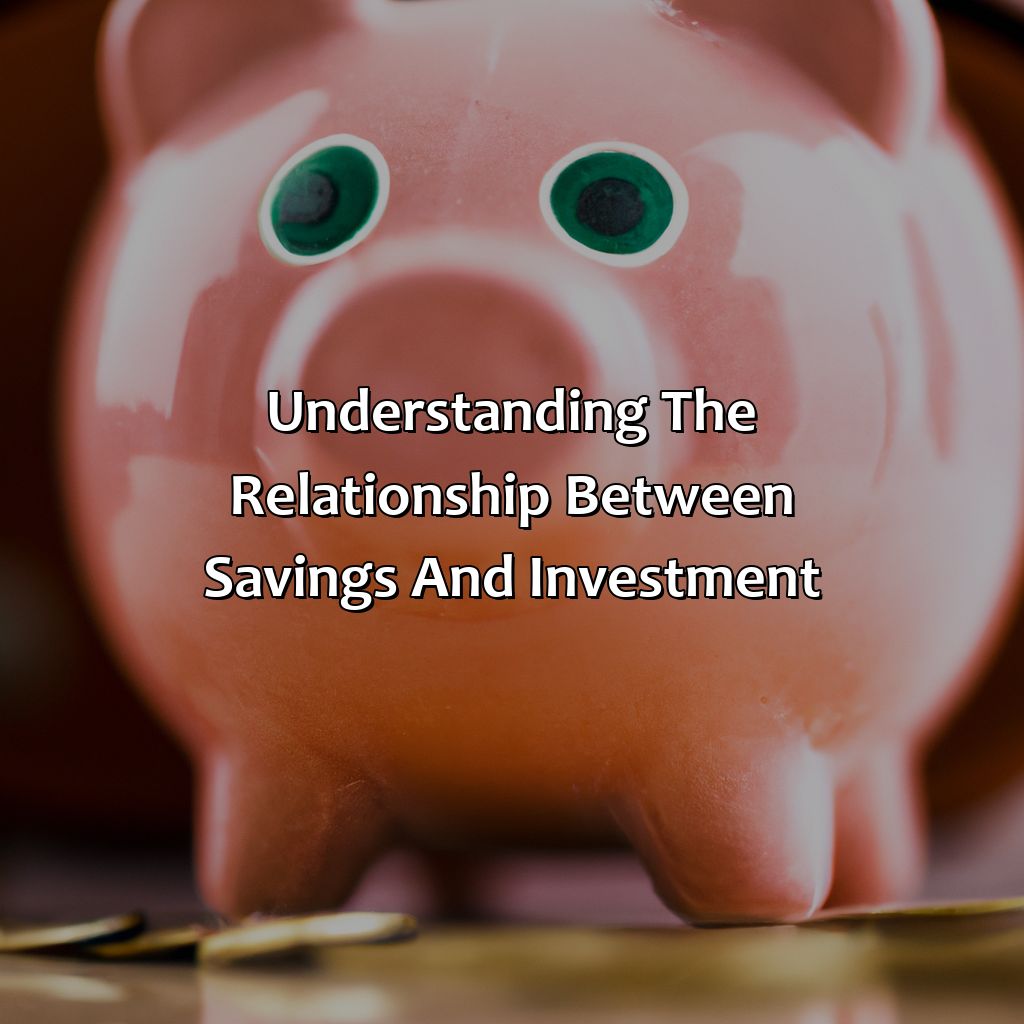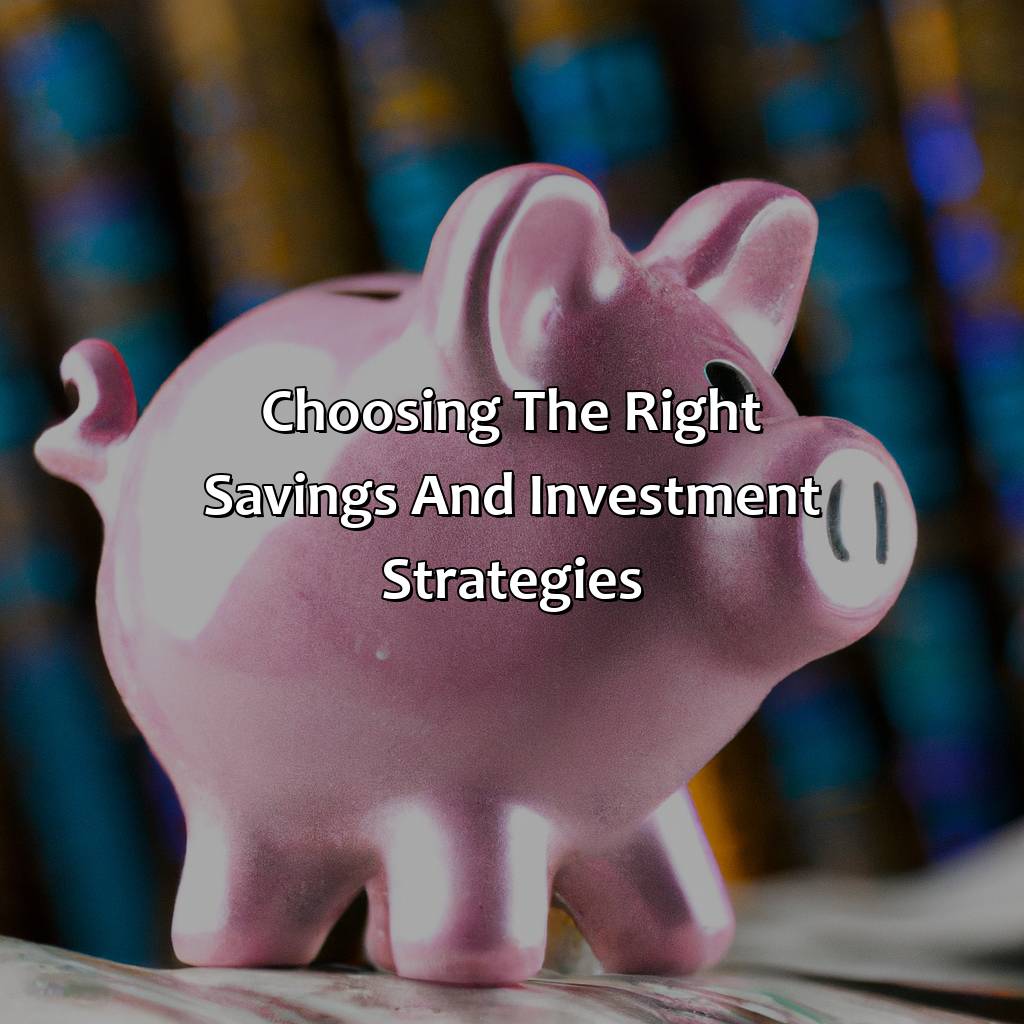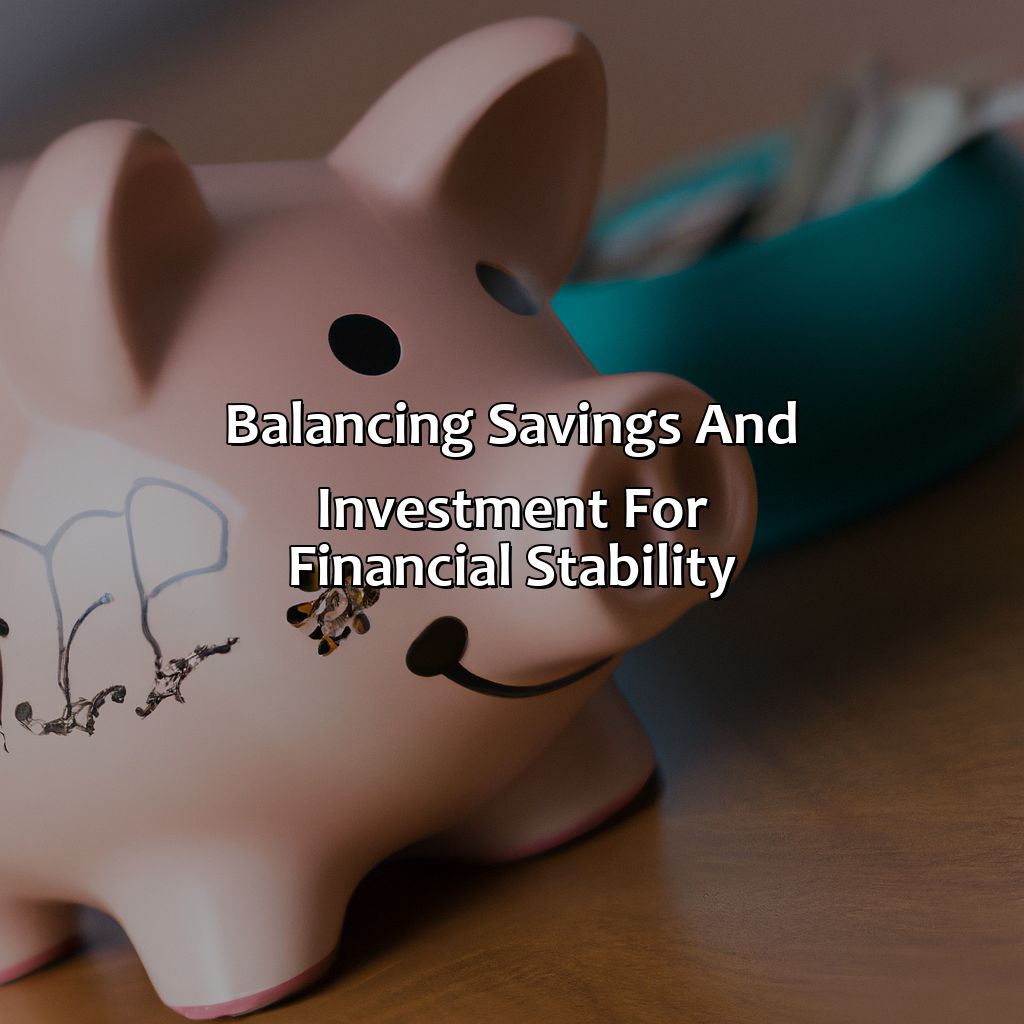How Are Savings And Investment Related?
Key Takeaway:
- Savings and investment are two important financial terms that go hand in hand. Savings is the money you set aside for future expenses or emergencies, while investment is the process of putting money into assets that generate income or appreciate in value.
- Both savings and investment are crucial for financial stability and achieving long-term financial goals. Savings acts as a safety net and provides a source of funds for investment opportunities, while investment can help grow savings and generate additional income.
- Choosing the right savings and investment strategies depends on personal financial goals, risk appetite, and time horizon. It is important to monitor and adjust your savings and investment plan regularly to achieve a balanced and optimal savings-to-investment ratio.
Are you struggling to understand how savings and investments are connected? This article will explain the relationship between these two concepts and provide insight into how you can make your money work for you.
The Basics of Savings and Investment
Savings and investment are two concepts which appear to be the same, but have different uses for your money. Let’s explore the variations between them to help you make more informed financial decisions. To begin, we’ll define savings and investment as solutions.

Image credits: retiregenz.com by Joel Washington
Defining Savings
Savings is the act of setting aside some income or money for future use, either in the short or long term, to meet emergencies, finance a project, etc. It involves keeping away part of one’s income from immediate consumption and spending it wisely. It is a fundamental aspect of personal finance and an essential stepping stone towards investment. By saving, individuals create a pool of funds that can be used for other purposes.
Moreover, savings have various forms such as regular savings accounts and Treasury Bills. Regular savings accounts are basic bank accounts that allow you to deposit your money and earn interest while doing so. Treasury Bills are short-term investments with relatively low risks rates which can provide cash flow at little inconvenience.
Importantly, it is essential to develop good saving habits early in life so as not to struggle at later stages during emergencies or when planning for long-term goals like paying off student loans or buying a home–a leading motivator for many savers.
It was not until the late nineteenth century that banks began setting up small savings programs specifically targeting children who wanted to save their pocket money instead of spending it right away. This led banks and financial institutions around the world to work more with developing countries where access to banking services for individuals was minimal, helping improve financial inclusion through practical channels such as mobile banking and other related activities.
Investment is like planting a tree, you have to nurture it and wait patiently for it to bear fruit – unless you’re investing in avocado toast, then it’s already overpriced.
Defining Investment
Investment refers to allocating resources in a particular financial vehicle with the intention of generating profit or income over time. The objective of investment can range from capital gains, dividends, interest, rental income, or a combination of these. Investment can be categorized into different types including stocks, bonds, real estate and mutual funds, among others.
In general, investment decisions are guided by factors such as risk tolerance, return expectations and investment horizon. Investors must also evaluate their ability to deal with market volatility in order to manage risks associated with investment.
It is important to note that savings and investment are interrelated; savings represent the initial step towards investing as it provides a pool of available funds that can be used for investment purposes. However, not all savings will eventually become investments; some may remain idle in low-yielding accounts or used for consumption purposes.
Successful investors formulate comprehensive strategies that maximize returns while minimizing risks through diversification across sectors and assets classes.
True story: Jane saved $10,000 from her summer job earnings with the idea of going on an adventurous trip across Europe during her gap year. However after doing some research on investing options available to her, she realized her money could grow even more by investing in mutual funds instead of letting it sit idle in her savings account. After careful consideration she allocated $5,000 into a short term bond fund and invested the remaining $5,000 into large cap equity fund which ended up yielding significant returns within 6 months.
Saving money without investing is like buying a boat and keeping it in your backyard – it may look pretty but it’s not going anywhere.
Understanding the Relationship Between Savings and Investment
Grasp the link between savings and investments by delving into ‘The Importance of Savings in Investment’ and ‘How Investment Can Help Grow Savings’.
These sub-sections will explain how saving cash can help your investments. And, how investment can help your savings develop.
By looking into these two sub-sections, you can gain knowledge about the dual advantages of saving and investing to make wise financial decisions.

Image credits: retiregenz.com by Harry Duncun
The Importance of Savings in Investment
The correlation between savings and investment is essential in building wealth. Savings provide the initial capital for investment opportunities, enabling individuals to increase their assets and achieve long-term financial goals.
Investment is a tool that allows individuals to grow their financial assets and receive a return on their investments. In contrast, savings focus on accumulating funds to make a sizable investment. Thus, the importance of savings lies in creating the capability to invest.
Additionally, consistent saving over an extended period can lead to compounding interest, which can have a significant impact on returns. Therefore, it’s crucial to prioritize saving alongside investing.
Saving and investing are intertwined; one cannot be efficient without the other. Although each may hold different objectives, savings’ importance ultimately results in creating opportunities for investments that might otherwise be unattainable.
According to Statista Global Consumer Survey 2021, 53% of global respondents stated that they regularly save money every month as part of their long-term financial goals.
Investment is like giving your savings a personal trainer, helping them gain more muscle (money).
How Investment Can Help Grow Savings
Investment is a key factor in increasing the growth of savings. Through investment, individuals can generate returns and earn profits on their initial capital. This not only provides additional income but also accelerates the accumulation of funds which can be reinvested or saved for future needs.
Investing in various asset classes such as stocks, bonds, mutual funds, and real estate can also help diversify one’s portfolio and minimize risk. By investing in different types of assets, one has multiple sources of income and can protect against potential losses due to market fluctuations.
In addition, regular investing in small amounts over an extended period using tools like Systematic Investment Plans (SIPs) can result in compounding benefits. The power of compounding ensures that the returns earned on investments are added back to the initial amount, the total sum of which is reinvested for further gains resulting in exponential growth over time.
To grow savings through investment, it is important to conduct appropriate research, seek professional advice, and adopt a disciplined approach to investing by setting clear financial goals and sticking to a long-term plan. Patience and perseverance are key factors that determine success in investment.
Overall, investment plays a crucial role in growing savings by generating additional income, diversifying one’s portfolio, minimizing risks, compounding benefits and providing future security for unforeseen events.
Savings and investment are like a game of Jenga – remove the wrong factor and everything comes crashing down.
Factors That Affect Savings and Investment
Gain clarity on how to save and invest with a focus on economic conditions and market trends. Plus, comprehend the connection between personal financial goals and habits. These subsections will educate you on macro and microeconomic factors influencing investment decisions. Understanding how personal financial goals and habits tie in with investing and saving can help optimize financial decisions.

Image credits: retiregenz.com by Joel Jones
Economic Conditions and Market Trends
The interconnection between economic climate and market trends is a crucial aspect that cannot be neglected. These factors play a significant role in determining the outcome of savings and investment.
Market trends are changing constantly, and it triggers alterations in economic conditions. As the economic climate varies, so does the investment opportunities available. Therefore, individuals should keep up with these transformations to maximize their gains.
There exist numerous factors that trigger changes in market trends and can affect investments negatively or positively. These include social unrest, political policies, international relations, technological advancements among others.
Stay informed about the changes happening around you. Keeping track of political policies can help one identify potential government-sponsored investments that they may want to consider before it’s too late.
It’s imperative to stay knowledgeable under all circumstances and be able to interpret economic information accurately. Informed decisions lead to better returns on investments than uninformed ones.
Setting financial goals is like going on a road trip – without a destination, you’ll just end up driving in circles and running out of gas.
Personal Financial Goals and Habits
The financial objectives and patterns of a person are key factors in their saving and investment behavior. These goals may include short-term targets like accumulating capital for emergency funds or long-term strategies such as paying off mortgages. Habits like budgeting, frugality, and assessing risks can impact one’s ability to save regularly and invest wisely.
Additionally, mindset is fundamental: having a growth-oriented outlook increases the likelihood of successful savings endeavors. Implementing realistic plans with specific timeframes makes it easier to achieve desired outcomes.
A significant aspect that affects these habits is consumer behavior, including social norms and marketing tactics. The attitudes of family, colleagues, and society influence our choices in regards to money management, particularly related to spending patterns and investment risks.
Studies show that women score higher in financial management metrics when compared to men on average. However, women investors are more risk-averse than their male counterparts.Source: Investopedia
Better choose the right savings and investment strategy than let your money play a game of chance.
Choosing the Right Savings and Investment Strategies
Pick your saving and investing plans! Check out the subsections for various types of savings accounts and investment options. Think of your risk level and long-term goals before deciding.

Image credits: retiregenz.com by Yuval Arnold
Different Types of Savings Accounts
There are various categories of accounts provided by banks and financial institutions for customers to save their money. Every type of savings account complements an individual’s specific financial goals. The following table covers the classification of savings accounts depending on their distinct characteristics.
| Type of Savings Account | Key Features |
|---|---|
| Basic Savings Account | Offers low-interest rates with minimal requirements |
| High-yield Savings Account | Provides high-interest deposits but requires a large minimum balance |
| Money Market Accounts | Deposits earn interest that varies according to market conditions |
| CDs (Certificates Of Deposit) | Offers a fixed interest rate and fixed period, which is agreed upon during the time of opening account |
It’s essential to choose the right account that complements your financial situation with features like competitive interest rates, minimal requirements, high-yield deposits, and fixed rates and periods that suit your needs and preferences.
Looking for competitive interest rates drives people towards selecting a particular type of savings account; however, each type should be considered carefully to ensure optimal use.
Decades ago, there were not many choices in savings accounts; however, as banking systems have developed, so have varieties of saving accounts available today.
Choose your investment options wisely, because you never know when the stock market will decide to take a holiday.
Investment Options Based on Risk Appetite and Time Horizon
When it comes to investing, selecting appropriate strategies based on one’s risk appetite and time horizon is crucial. Here’s a breakdown of investment options:
| Investment Strategy | Risk Level | Time Horizon |
|---|---|---|
| Savings Account | Low | Short-Term (Up to 2 years) |
| Bonds/Fixed Income Investments | Low-Moderate | Short-Term-Mid-Term (2-5 years) |
| Mutual Funds/ETFs/Index Funds/Diversified Equity Funds | Moderate-High | Mid-Term-Long Term (5-10 Years) |
| Estate Planning or Annuity Products | High | Long Term |
Furthermore, each investment strategy has its unique characteristics in terms of returns, risks and liquidity. Considering an individual’s savings and investment goals would aid in deciding the appropriate option.
Don’t miss out! Take the first step towards achieving your financial goals today by selecting the right savings and investment strategy that best suits you.
Balancing savings and investment is like juggling knives – one wrong move and it can be a bloody mess.
Balancing Savings and Investment for Financial Stability
For financial security, you must balance savings and investments. We’ll look at the ideal ratio of savings to investments. Plus, we’ll discover how to consistently watch and adjust your savings and investment plan for ultimate fiscal assurance.

Image credits: retiregenz.com by Adam Woodhock
Finding the Optimal Savings-to-Investment Ratio
Achieving Financial Stability: Tips for Finding the Perfect Balance between Savings and Investment
The right balance of savings and investment is crucial in achieving financial stability. It isn’t about sacrificing one over the other but knowing how much you can allocate without compromising your financial goals. It’s important to determine the optimal savings-to-investment ratio that aligns with your long-term plans.
One way to find the perfect balance is by considering your income, expenses, and debts when creating a budget plan. Afterward, look into potential investment options and diversify your portfolio based on your financial goals, risk tolerance, and time horizon. Aiming for a 50-30-20 rule for budgeting provides enough room for covering daily expenses while also allowing you to save some amount and invest in viable vehicles.
Moreover, it’s intelligent to prioritize emergency funds before investing in high-risk ventures such as stocks or cryptocurrency, as saving accounts guarantee liquidity during unforeseen circumstances like accidents or job loss. Finally, regularly monitoring and adjusting your portfolio according to market trends ensures that it remains aligned with your long-term financial goals.
A friend of mine was once so focused on saving money that he missed out on potential investment opportunities that could have helped him earn more than what his savings account offered. He later realized that maintaining an appropriate balancing act between savings and investment would have been more financially helpful in the long run.
Monitoring and Adjusting Your Savings and Investment Plan.
To ensure financial stability, it is crucial to keep your savings and investment plan under control. By maintaining a balance between the two, you can safeguard your funds while also growing your money. Here are some ways to achieve this:
- Regularly review your budget and make adjustments accordingly.
- Set specific goals for your savings and investments.
- Monitor and analyze your portfolio’s performance regularly.
- Stay informed on changes in the market and adjust your investments accordingly.
Monitoring and Adjusting Your Savings and Investment Plan is imperative for long-term financial security. Apart from the steps mentioned above, you can work with a professional financial advisor who will guide you in drafting a personalized plan that accounts for your unique needs.
It’s essential to prioritize saving and investing, or else you might lose out on opportunities that come with compounded interest over time. Take charge of your finances today by monitoring and adjusting your savings and investment plan accordingly.
Five Facts About How Savings and Investment Are Related:
- ✅ Savings is the money you set aside for future use, while investment is the act of putting that money to work to grow your wealth. (Source: The Balance)
- ✅ Savings is often a prerequisite for investment, as you need money in order to invest. (Source: Investopedia)
- ✅ Investment returns can contribute to savings, as the profits earned can be used to increase one’s savings. (Source: The Motley Fool)
- ✅ Savings and investment are both important components of a comprehensive financial plan. (Source: Forbes)
- ✅ Saving and investing early and consistently can lead to greater long-term financial stability and success. (Source: NerdWallet)
FAQs about How Are Savings And Investment Related?
How are savings and investment related?
Savings and investment are related because savings can be used as a source of funds for investment.
Why is it important to understand the relationship between savings and investment?
Understanding the relationship between savings and investment can help individuals make informed financial decisions and plan for their future financial goals.
What are some examples of savings that can be used for investment?
Some examples of savings that can be used for investment include personal savings accounts, certificates of deposit, money market accounts, and retirement accounts such as 401(k)s and IRAs.
Can investing help increase savings?
Yes, investing can potentially help increase savings over time through the power of compounding returns. By earning a return on invested funds, individuals can potentially increase their overall savings.
What are some risks involved with investing savings?
Investing savings involves risks such as market fluctuations, potential loss of principal, and inflation. It is important to understand these risks before investing and to diversify investments to minimize risk.
Can a financial professional help me understand the relationship between savings and investment?
Yes, a financial professional such as a financial advisor or accountant can help individuals understand the relationship between savings and investment and develop a personalized financial plan.
